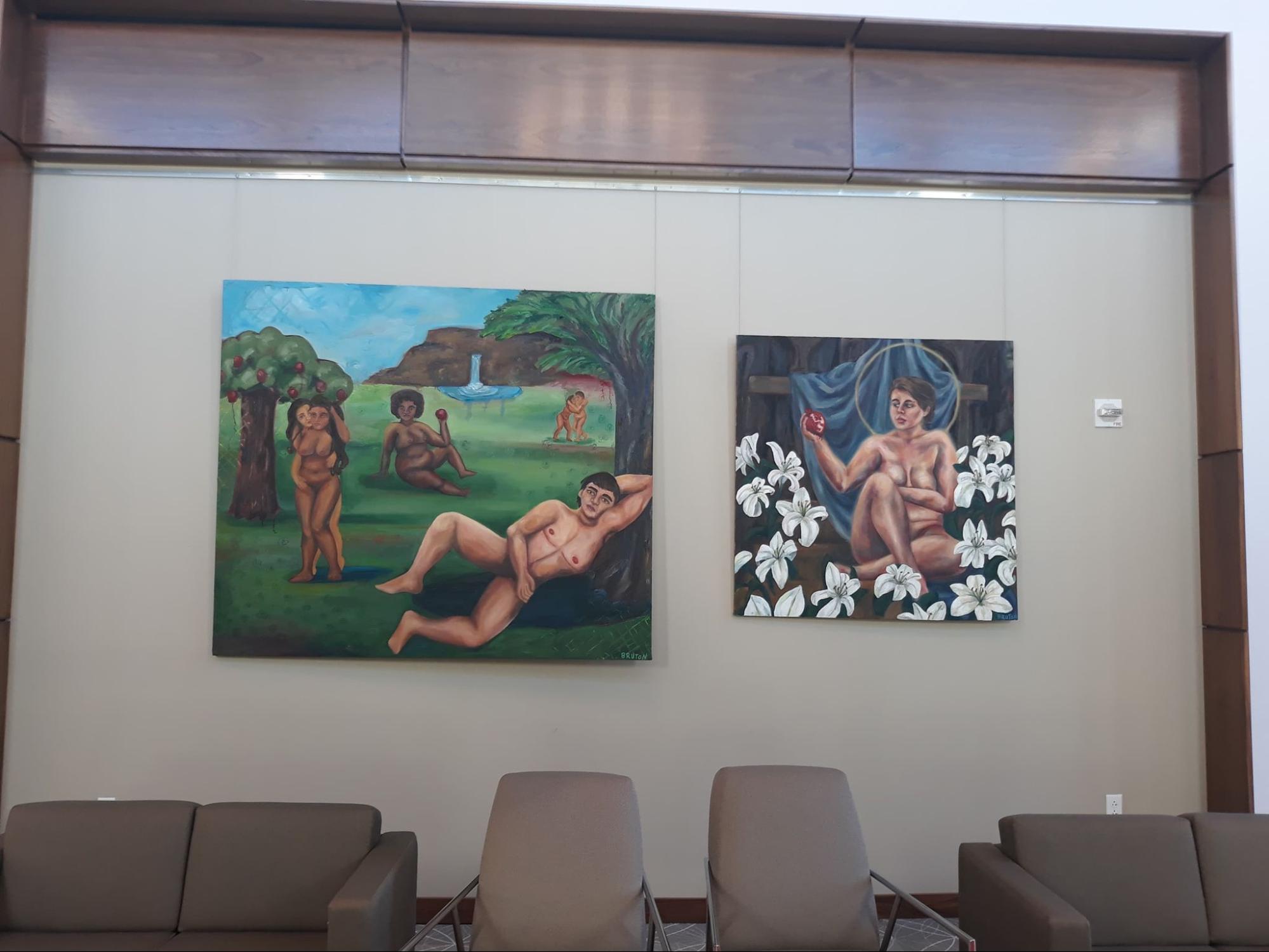By Holden Davitian, Staff Editor
If you frequent Haverford’s Lutnick Library, you’ve probably noticed a few unique art pieces hanging on the walls. Unlike the other portraits of presidents and donors scattered throughout the library, these paintings are evocative and attention-grabbing—featuring nudity and curvy bodies—courtesy of a current Haverford student, Ainsley Bruton ‘21, who says that the pieces reflect on “what it’s like to have a body and move through the world.”
Bruton completed all four pieces as part of her independent study. However, the series was actually spurred as one singular piece. The white lillies entitled “Give Me My Fucking Body Back” originated as “a side project and never really got anywhere,” according to Bruton, but then she decided to “bring it into an actual class so these were part of an independent study.”
Even before the paintings’ completion, Bruton knew they were meant to be showcased. Struck by the bare walls in the newly renovated library and, having been a student of the Head Librarian at Lutnick, Bruton took initiative and simply asked if she could use the empty walls as a place to hang her art. She explains that although at this point the series wasn’t done, she still knew there would ultimately be four pieces, “but didn’t know at all what they were going to look like or what they were.”
With the knowledge that her painting would be displayed in the library, Bruton better appreciated the gravity of her work. She outlines that she liked how her first painting of the woman and flowers worked in the space and thus continued the other paintings with the understanding that “it was mostly kind of about the dimensions,” to ensure the series would fit in her given space.
Overall, Bruton wanted to illustrate through her paintings “the social constructs and ideas that we place onto bodies that make them mean different things to us.” Each piece would refer to a specific construct she had identified.
In the first piece, “Give Me My Fucking Body Back,” Bruton incorporates religious symbols to comment on the interpretation of bodies in Christianity. For example, the cross, the gold nimbus above the nude woman, and the white flowers act as symbols of divinity to portray “the important ideas of purity and virginity in the Christian religion.” Bruton explains that the story behind her choice to incorporate a pomegranate illustrates her use of both thematic and aesthetic elements. She wanted to use the fruit as an allusion to the “fruit of thy womb” and to the fact that pomegranates were once used as a contraceptive. However, she also chose it because she liked the seeds and drippy forms that pomegranates make.

The next piece on the same wall is entitled: “Day Dreamin’, Gay-Schemin’; a Utopian World of Unthinkable Healin’.” Bruton wanted to touch on art history and historical art traditions while contrasting it with queerness and utopia. She details how this specific piece is “a little different than the others” as it doesn’t take the same form as the other painting in terms of commenting on a social structure. Instead, Bruton is exploring “how bodies are represented over a breadth of time and why bodies are certain ways and how they could be different” with use of the older art traditions and her imagination of a “queerness and utopia.”
The first painting in the hallway of the skeleton called “A (facts not feelings) diagram of the human body” illustrates gender and gender performativity in the practices of medicine, whereas the second piece, “At one with your soul (I’m not trying to sell you anything)” is a critique on the use of bodies in media and advertising.

Finally, Bruton uses her paintings to allude to visual culture and to demonstrate how images act as archives in our lives. She hopes the topics of advertising, queerness, and religion help viewers understand how the visual language that we are accustomed to today has come about and to “see how our culture today is engrained with of certain imagery, iconography, and symbolism.”

Through all four of these large oil paintings, Bruton seeks for each painting to take on its own distinct meaning. While Bruton reiterates that “everything is intentional,” she hopes people pick up on the wider themes of her work, including its references to religion and medicine.
Concerning her works’ titles, Burton wanted to have fun and show that the viewers that despite the strong messages conveyed, the pieces “do not have to be taken too seriously.” She concludes with expressing her great pride and excitement towards her instillation in Lutnick Library, stating that she is so happy she can “make art for an audience and to be able to have other people engage with the pieces to make them into something different.”
Image credit: Holden Davitian
